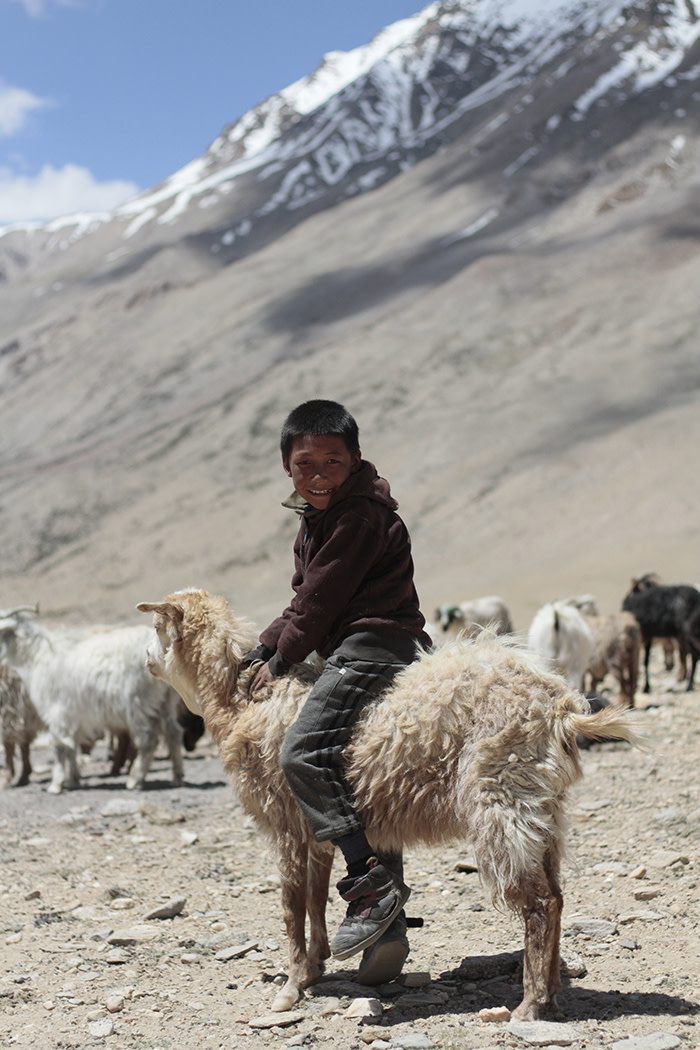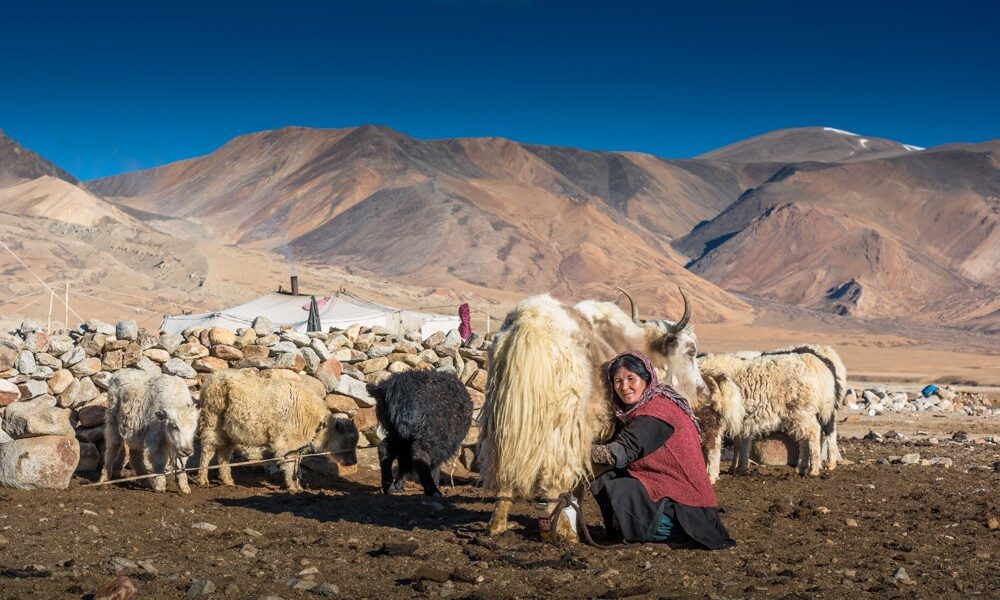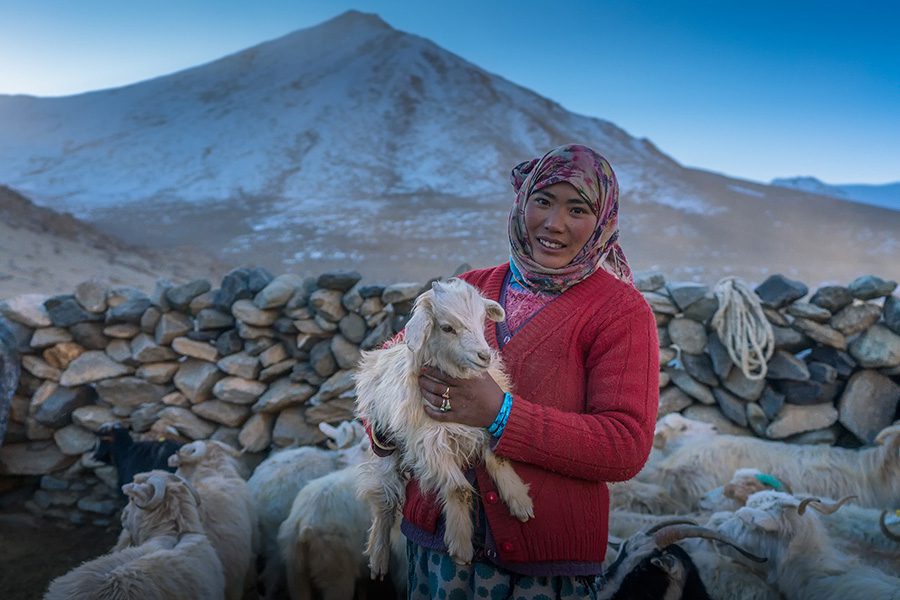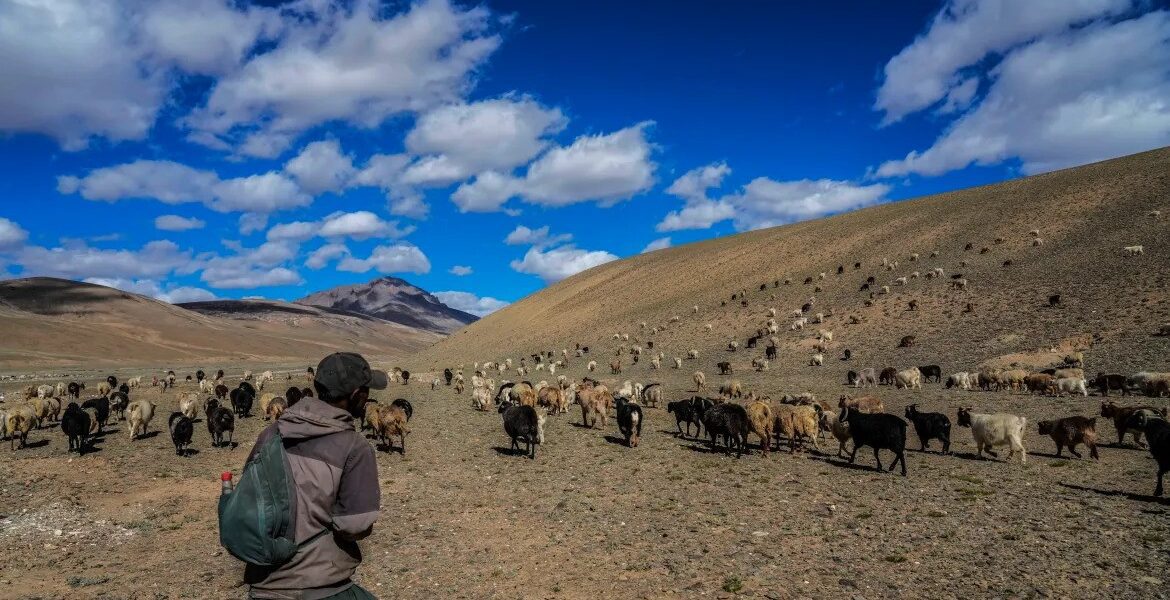The Changpa herders of Ladakh represent one of the last remaining nomadic tribes in the Himalayan region. For centuries, their unique lifestyle has revolved around the high-altitude Changthang Plateau, where they have maintained an intricate relationship with the land, their animals, and the harsh environment. However, the Changpa lifestyle is under threat due to modernization, climate change, and socio-economic pressures.
In this blog, we’ll delve into the fascinating world of the Changpa herders, exploring their traditions, challenges, and the urgent need to preserve their way of life.
Introduction: Who Are the Changpa Herders?
The Changpa tribe is an indigenous nomadic community of Ladakh, renowned for their pastoral practices and expertise in Pashmina wool production. Residing in the Changthang Plateau, which extends into Tibet, the Changpa herders have thrived in one of the world’s harshest climates.
Their name, derived from the Tibetan word “Chang,” meaning “north,” signifies their connection to this remote region. These herders primarily rear Pashmina goats, famous for producing the luxurious wool that is a hallmark of Ladakh’s economy.
Customer Testimonial:
“Visiting the Changpa herders was a life-changing experience. Their resilience and connection to the land are truly inspiring. I wish more people could understand the value of their culture before it’s too late.”
— Sarah Johnson, Environmental Scientist, USA
The Changthang Plateau: Heart of the Changpa Lifestyle
The Changthang Plateau, located at an altitude of over 14,000 feet, is the lifeblood of the Changpa people. This vast, cold desert is dotted with saltwater lakes, sparse vegetation, and rolling hills, making it a challenging yet integral part of their nomadic existence.

Key Features of the Changthang Plateau
| Feature |
Details |
| Altitude |
Ranges between 14,000 and 16,000 feet |
| Climate |
Harsh winters with temperatures dropping to -40°C |
| Wildlife |
Home to kiang (wild asses), snow leopards, and black-necked cranes |
| Economic Importance |
Vital for Pashmina goat rearing and seasonal grazing |
The plateau’s high-altitude grasslands provide grazing for the Pashmina goats, while the isolation fosters a strong community bond among the Changpa.
A Unique Way of Life: Traditions and Practices of the Changpa Tribe
Daily Routines and Nomadic Living
The Changpa herders lead a life dictated by the seasons. During summer, they migrate to higher pastures, setting up temporary camps. In winter, they move to sheltered areas to protect their livestock from the extreme cold.
Their daily tasks revolve around tending to the Pashmina goats, preparing dairy products like butter and cheese, and maintaining their rebo (traditional tents).
The Role of Pashmina Goats in Changpa Livelihood
Pashmina wool, often referred to as “soft gold,” is the cornerstone of the Changpa economy. The goats are not only a source of wool but also provide milk and meat, ensuring the tribe’s survival in the harsh terrain.
Did You Know?
One Pashmina shawl requires the wool of three goats and can take up to six months to make, showcasing the intricate craftsmanship of Ladakhi artisans.
Tents and Dwellings: A Reflection of Sustainable Living
The rebo, made from yak wool, is a marvel of sustainable architecture. These portable tents are designed to withstand fierce winds and freezing temperatures while being easy to dismantle during migration.

Customer Testimonial:
“The Changpa’s rebo is a symbol of their resourcefulness. Seeing how they live sustainably has inspired me to adopt eco-friendly practices in my own life.”
— Marco D’Angelo, Architect, Italy
Challenges Faced by Changpa Herders in Modern Times
Climate Change and Harsh Winters
Unpredictable weather patterns and prolonged winters have made it increasingly difficult for the Changpa to sustain their herds. Snowfall is heavier, reducing access to grazing lands and causing higher goat mortality rates.
Impact of Modernization on Nomadic Traditions
Modern influences, such as the allure of urban lifestyles and access to education, are leading younger generations to abandon traditional practices.
Encroachment and Loss of Grazing Lands
Conservation policies and growing tourism have restricted the Changpa’s access to grazing lands. This encroachment threatens their nomadic way of life and disrupts their centuries-old traditions.

Preserving the Heritage of Ladakh’s Changpa Tribes
Community Efforts and Cultural Programs
Local NGOs and cultural groups are working to document Changpa traditions and promote their crafts, such as weaving and wool processing.
Role of Eco-Tourism in Supporting Nomadic Tribes
Eco-tourism initiatives, such as homestays and guided tours, offer a sustainable way to generate income while educating visitors about the Changpa lifestyle.
Policies and Government Initiatives for Changpa Conservation
Efforts are underway to provide subsidies for Pashmina wool and support for grazing land rights. However, much more needs to be done to ensure long-term sustainability.

Q&A Section
Q: What is the primary livelihood of Changpa herders?
A: The Changpa rely on herding Pashmina goats, which provide wool, milk, and meat.
Q: How is climate change impacting Ladakh’s Changpa tribe?
A: Climate change has led to unpredictable weather, reducing grazing land and increasing livestock mortality.
Q: What are the main challenges faced by the Changpa community?
A: Encroachment, modernization, economic pressures, and climate change are the primary challenges.
Q: Why is Pashmina wool significant to the Changpa lifestyle?
A: Pashmina wool is their main source of income, sustaining their economy and cultural identity.
Q: How can tourism support the Changpa herders?
A: Responsible eco-tourism can generate income, raise awareness, and promote cultural preservation.
Q: What steps are being taken to preserve Ladakh’s nomadic cultures?
A: Efforts include policy reforms, subsidies, cultural documentation, and eco-tourism initiatives.
Ladakh Nomadic Tribes
Ladakh Nomadic Tribes | The journey through Ladakh mirrors the very essence of unraveling unknown horizons, as its dramatic landscapes and unique cultural identity awaken the deepest sense of wonder and exploration. Ladakh Nomadic Tribes delves into this realm where inner peace intertwines with the wild, untouched beauty of Ladakh. From the snow-capped peaks to the serene monasteries, every step in Ladakh is a step toward self-discovery. The mountains, ancient paths, and unspoken mysteries stretch before travelers, offering a meditative experience where each encounter feels both effortless and transformative. Whether it’s trekking across remote valleys or sitting quietly beside a sacred lake, Ladakh invites those who seek a deeper connection to the natural and spiritual world.

Ladakh Nomadic Tribes
The monasteries of Ladakh stand as living monuments to the region’s profound spiritual heritage. With origins dating back over a thousand years, these ancient structures are both places of worship and repositories of art, culture, and wisdom. Hemis Monastery, one of the largest in Ladakh, is renowned for its annual festival, featuring colorful mask dances performed by monks. The history of these monasteries reflects Ladakh’s role as a crossroads between India, Tibet, and Central Asia, where religious and cultural influences have intertwined over the centuries.
The Tibetan Buddhist influence is especially evident in the architecture and daily life of the monks. Prayer wheels, intricate murals, and the soft hum of chants fill the air as visitors explore the monastery grounds. Each monastery, from the remote Lamayuru to the awe-inspiring Thiksey, offers a window into the spiritual heart of Ladakh. These centers of meditation, learning, and community life continue to thrive, preserving traditions that have shaped Ladakh for generations.
Why Visit Ladakh for Ladakh Nomadic Tribes?
Ladakh is a destination that transcends mere travel. It offers a journey that touches both the outer and inner landscapes, making it a perfect setting for those who seek to unravel their own unknown horizons. The region’s breathtaking scenery—from towering mountain ranges to hidden valleys—provides not just an escape but a space for contemplation and growth. Ladakh’s culture, deeply rooted in Buddhist practices, invites visitors to reflect on their own lives and the world around them.
Ladakh’s people, known for their warmth and hospitality, add to the richness of the experience. Villages like Sumda Chun and the legendary Nubra Valley introduce travelers to a way of life that is intricately connected to nature and spirituality. Staying in local homestays allows for immersive experiences where one can learn about traditional Ladakhi customs, share meals made from local produce, and participate in community rituals.

Beyond its natural beauty, Ladakh offers a unique opportunity to explore oneself. The vastness of the region’s plateaus and the clarity of its skies seem to mirror the vastness of the human spirit. Whether it’s standing atop a mountain pass at 18,000 feet or meditating in a centuries-old monastery, Ladakh helps unravel the unknown horizons within each traveler.
Finding the Best Ladakh Nomadic Tribes in Ladakh
Finding the best places in Ladakh to experience “Ladakh Nomadic Tribes” involves venturing off the beaten path. Ladakh’s lesser-known treks, such as those leading to secluded monasteries or high-altitude lakes, offer unparalleled opportunities for solitude and reflection. The Markha Valley trek, for instance, takes travelers through verdant valleys, ancient villages, and high-altitude passes, allowing for both physical and spiritual exploration.
Ladakh’s iconic lakes, including Pangong Tso and Tso Moriri, are ideal spots for quiet contemplation. Their still waters reflect the sky, creating a mesmerizing landscape that feels timeless and infinite. Sitting beside these lakes, especially at dawn or dusk, brings an overwhelming sense of peace and connection with nature.

For those interested in Ladakh’s spiritual heritage, exploring monasteries such as Alchi, Phyang, or Diskit can be a transformative experience. These sites are not just places of worship but also centers of art, philosophy, and wisdom. Visiting these monasteries, with their ancient murals and intricate statues, offers insight into Ladakh’s rich cultural tapestry.
Ladakh’s Atmosphere and Ladakh Nomadic Tribes
Ladakh’s atmosphere is unlike any other place on Earth. The stark contrasts between the rugged mountains and the serene, tranquil monasteries create an environment that feels both raw and sacred. The traditional decor in Ladakhi homes and religious sites reflects this balance, with mud-brick houses adorned with prayer flags and colorful thangkas (Buddhist paintings) that add warmth and spiritual meaning to the space.

The interiors of Ladakhi homes, often simple and functional, are filled with symbols of devotion. Small shrines dedicated to Buddhist deities are common, and the air is often fragrant with incense. The use of earthy materials, like stone and wood, along with brightly colored textiles, creates an inviting and peaceful space, perfect for relaxation and reflection.
Traditional Ladakh Nomadic Tribes
Traditional Ladakh Nomadic Tribes is an integral part of the region’s identity, offering a unique blend of flavors that reflect its harsh climate and remote location. Hearty, warming dishes such as thukpa (noodle soup) and momos (dumplings) provide the sustenance needed to endure Ladakh’s cold temperatures. Skyu, a thick stew made with root vegetables and barley, is another staple of the Ladakhi diet, designed to nourish both body and spirit.

Drinks like butter tea, made with yak butter and salt, are a must-try for anyone visiting Ladakh. This rich, savory drink is not only warming but also hydrating, making it essential for those venturing into the high-altitude regions of Ladakh. Chang, a local barley beer, is often enjoyed during festivals and community gatherings, adding a sense of joy and camaraderie to any occasion.
Live Cultural Ladakh Nomadic Tribes in Ladakh
Ladakh is home to a vibrant cultural scene, with festivals and live performances held throughout the year. The Hemis Festival, which celebrates the birth of Guru Padmasambhava, is one of the largest and most famous events in the region. Monks dressed in elaborate costumes perform cham dances, which depict the triumph of good over evil. The energy of the festival, with its bright colors, rhythmic music, and elaborate rituals, draws visitors from around the world.
Other local festivals, such as the Losar (New Year) and Ladakh Festival, provide visitors with the chance to witness traditional dance, music, and crafts that have been passed down through generations. These events are more than just entertainment; they are a celebration of Ladakh’s rich cultural heritage and its deep connection to the spiritual world.
Trekking and Outdoor Activities Ladakh Nomadic Tribes
Ladakh is a trekker’s paradise, offering some of the most stunning and challenging routes in the world. From the famous Ladakh Nomadic Tribes, which follows the frozen Zanskar River, to lesser-known routes like the Sham Valley or Nubra Valley treks, Ladakh’s landscape offers endless possibilities for adventure and discovery. The high-altitude passes, such as Khardung La and Chang La, offer breathtaking views of snow-capped peaks and sprawling valleys.

Wildlife enthusiasts will also find Ladakh Nomadic Tribes to be a haven for rare species such as the snow leopard, Himalayan blue sheep, and the Tibetan wild ass. Winter expeditions to spot the elusive snow leopard in the Hemis National Park are gaining popularity among wildlife photographers and conservationists alike.
The Importance of Preserving Ladakh’s Ladakh Nomadic Tribes
Ladakh’s rich cultural and environmental Ladakh Nomadic Tribes is under increasing threat from climate change and mass tourism. Preserving this unique region requires careful attention to sustainable tourism practices. Choosing eco-friendly accommodations, supporting local businesses, and participating in community-led conservation efforts are just a few ways that visitors can contribute to the preservation of Ladakh’s natural and cultural heritage.
Ladakh’s people have a long history of living in harmony with their environment, practicing sustainable agriculture, and maintaining a deep spiritual connection to the land. Visitors are encouraged to follow the same principles, leaving no trace and respecting the fragile ecosystems that make Ladakh so special.
Etiquette and Tips for Visiting Ladakh Nomadic Tribes
Before visiting Ladakh, it’s essential to understand and respect the region’s customs and traditions. As a deeply spiritual place, Ladakh requires visitors to dress modestly, especially when visiting monasteries or attending religious ceremonies. Always ask for permission before taking photographs inside monasteries or of local people.
Medical Ladakh Nomadic Tribes
Spa trail Ladakh Nomadic Tribes
Ladakh Nomadic Tribes

When Ladakh Nomadic Tribes, remember to stay on designated paths to avoid damaging fragile ecosystems. Tipping is appreciated but not expected in most settings, and it’s important to carry cash, as many remote areas do not accept credit cards. Lastly, be mindful of altitude sickness and take the necessary precautions when traveling to higher elevations.
Conclusion: Enjoying Ladakh Nomadic Tribes in Ladakh
Ladakh is a place where the physical and spiritual worlds converge, offering travelers a journey unlike any other. Whether you’re trekking across high-altitude deserts, exploring ancient monasteries, or simply sitting in quiet reflection by a mountain lake, Ladakh invites you to unravel your own unknown horizons. By respecting the region’s traditions and practicing sustainable tourism, you help ensure that Ladakh’s beauty and cultural richness will be preserved for future generations to explore and enjoy.












